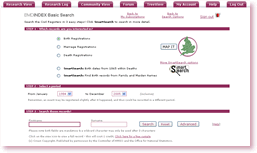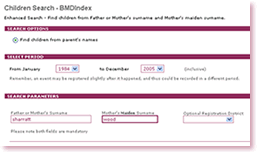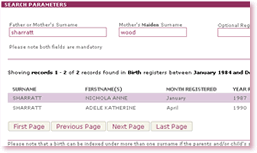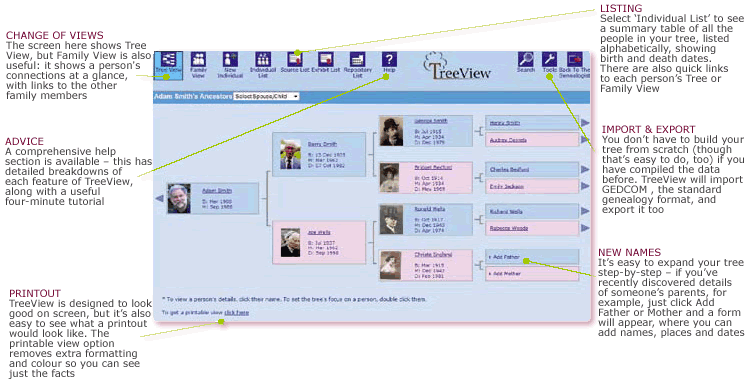|
January 2010 Promotional Feature
 |
This leading family-run site has a host of unique features and millions of records to explore |
In the cut-and-thrust world of genealogy websites, one stands out for its friendly ethos and impressively broad range of content: The Genealogist. It's easy to see why the site was voted Census and BMD site of the year in the 2008 Your Family Tree Awards, where it was praised for its collection of both census transcripts and original page images, and its clever search tools for birth, marriage and death records.
The site has perhaps the widest rang of data available, too - everything from a database of the Knights of England going all the way back to 1127, to civil registration indexes from as recently as 2005.
You might expect the firm behind such a large site to be a huge, faceless corporation, but what's all the more impressive is that it's a family-run business. Nigel and Sue Bayley set up the sister company, S&N Genealogy Supplies, back in 1992, and since then have expanded the business year after year - their three sons all work for the business, one of them writing the innovative web code behind many of The Genealogist's unique features.
A genealogy business that's all about family - what could be more appropriate? But why should you use The Genealogist? Below are 15 great answers to that question... |
|
 Images and Transcripts Images and Transcripts
Various sites offer large
collections of census data, but
The Genealogist is the only one
that has both transcripts and
original page images for all
the censuses for England and
Wales from 1841 to 1901.
Census transcriptions provide
you with much more information
than a mere index – they're fully searchable and give details for all
the family members. They take
the hard work out of trawling
through thousands of pages
of handwritten census material.
They provide information as clear,
typed text, searchable
by forename, surname, age,
occupation, relationship to head
of household and birthplace.
All this data is stored as plain
text, which means that even if
you don’t have a broadband
connection, you can get to
it quickly. If you do have
broadband, you'll enjoy the
benefit of seeing the original
census images.
 1000s of parish records 1000s of parish records
Parish records are the most
important source of information
for family historians prior to civil
registration beginning in 1837,
and in many cases they date back
to the early 1500s. Few other
websites have managed to gather
together a significantly large
collection of them. The
Genealogist transcribes original
parish records and |
produces searchable databases of baptisms,
marriages and burials and, where
permission is granted, even
makes images of the original
pages available. Much of this
work is undertaken in
conjunction with family history
societies around the country.
The complete collection of WP
Phillimore’s 19th century
transcriptions of marriage and
other records is available here. In
total, The Genealogist has parish
record transcripts for 21 English
counties, and parish records
taken from printed books for 28.
 Nonconformist Nonconformist
records
Parish records, important as
they are, only cover standard
Anglican churches. The
Genealogist has led the way in
providing easy, searchable access
to nonconformist records, too.
These cover Methodists,
Wesleyans, Baptists,
Independents, Protestant
Dissenters, Congregationalist, Presbyterians, Unitarians and
Quakers. They're invaluable for research prior to census and BMD
records. The data includes images
of early birth certificates and
registers, which cover baptisms,
marriages and burials. These
records and images are unique
to The Genealogist and can only
be found on this site and its
official sister site, www.BMDregisters.co.uk. |
"The Genealogist has led the way in providing access to nonconformist records"
 Wills & testaments Wills & testaments
Wills are a valuable source
of genealogical information.
They can give details of family
members, places of residence
and burial, as well as revealing
fascinating details about your
ancestors' possessions. A new feature for The
Genealogist is the Wills and
Testaments Index Viewer. To date,
this provides access to will
indexes for Bristol, Edinburgh,
Leicestershire, Northampton and
Yorkshire, with dates from the
16th century (14th for Yorkshire)
to the 18th. There’s also an Irish
Wills Index for 1536-1810 and
more than 460,000 indexes and
original page images for
Prerogative Court of Canterbury
probate jurisdictions from
1384-1858. |
|
 Step-by-step: SmartSearch Step-by-step: SmartSearch
The Genealogist's new SmartSearch function makes it easy to find recent BMDs
|

|
 |
 |
| 1 SmartSearch is a new way of searching
the birth, marriage and death data for
1984 onwards. It utilises an intelligent search
system to perform a reverse look-up. For this
example, you’ll need to go to the main BMD
index search page first and select the
1984-2005 collection. You’ll then see the
screen above. |
2 Let’s try SmartSearch for birth records
– click the second SmartSearch button and the new form shown above will appear.
All you need to do is enter the surnames of
the father and mother (maiden name), and
the system will comb through post-1984
records to see if any couples of those names
had children. |
3 And here they are – click ‘View’ next
to the names to see the full civil registration reference for ordering a certificate through the GRO . You can also
use SmartSearch to find birth records after
1865 for any death registered after 1984 –
making these connections so easily saves
a lot of time. |
|
 Directories Directories
Various directories have been
produced for well over 300 years
and can prove to be an invaluable
source of information about local
communities. The Genealogist
has many directories available,
from 1677 to 1905 and covering
39 counties from England and
Wales, plus a recently added
collection of 1905 directories
from Ireland.
If you're researching ancestors
alive at the time of the 1911
Census, directories from that era
have been helpfully grouped into
a special, easy-to-search ‘Circa
1911’ collection.
 School Registers School Registers
Registers from secondary,
further and higher education
are generally recent additions to
genealogy collections, and The
Genealogist has once again led
the way with a diverse collection.
Available at the site are registers
for nearly 20 educational
institutions around England and
Scotland, including Eton and
Rugby |
schools, and Aberdeen,
Glasgow, Oxford and
Cambridge universities.
There’s also an official list
of registered teachers
from 1917.
 Landowner Records Landowner Records
You'll find a 19th century
tax survey at The
Genealogist, which
provides an index to all
individuals who owned
land of one acre or more
in 1873. It’s arranged
alphabetically by county,
and you may find holdings
in more than one. It provides the
name of the owner, the town or
village where the land was
located, how much land they
owned and its estimated rental
value. The data covers all of
Britain and Ireland.
 Military Records Military Records
The Genealogist can help
with military research, too. In
addition to Army and Navy lists
for World War I, there’s a Navy
list for 1944, and a Roll of Honour
covering both World Wars.
Records include detailed
biographies with portraits
and information on birth |
date, birthplace, father’s
name, education, career, and
circumstances of death. The data
comes from the National Roll of
Honour, British Roll of Honour
and De Ruvigny’s Roll of Honour
(including photographs), with
over 1.5 million records included.
For WWII, the site also has
some notifications of deaths of
members of the British Armed
Services, prisoners of war,
civilians, internees and deaths
through lost aircraft, plus records
covering deaths in Japanese and
German internment camps.
 Surname Maps Surname Maps
The Genealogist’s BMD
index includes the fascinating
and useful ability to produce a
Surname Distribution Map
for any year from 1851 to
2002. This is a great way
to see where you may get the
best research leads and how
families dispersed.This feature is also available
for the censuses from 1841 to
1901 – use it, for example, to
find where your ancestors lived
before the boom in population
and rapid expansion to towns
and cities caused by the
Industrial Revolution. |
|
 TreeView: The site's tree builder TreeView: The site's tree builder
The Genealogist helps you build your family tree and more
|
 |
|
 Unique Search Tools Unique Search Tools
Along with the unique
SmartSearch system for birth,
marriage and death indexes, The
Genealogist has powerful search
tools to help you find ancestors in
the censuses and BMD records
that are unavailable elsewhere.
The new phonetic search system,
for example, is based on speech
patterns and the idea that
surname variations generally
sound the same despite wide
variations in spelling – this
feature is only available at The
Genealogist. You can also search
the site for groups of forenames
where a surname may have
varied over time.
 Keeping track of your research Keeping track of your research
The Genealogist’s handy
Research Log feature lets you
keep details of the people you’ve
found while searching through
the site’s databases. |
You can add
records to your research log from
the census transcripts, plus BMD
records from 1984 onwards, and
parish record transcripts will be
available soon.
 Free credits when you volunteer Free credits when you volunteer
The Genealogist's sister site, www.ukindexer.co.uk, lets you register
as a volunteer to help maintain
the site's reputation for high
quality data, as well as expand
the collections. You
can do as little or as much as
you like, and you can earn free
subscriptions or credits to use
at The Genealogist.
 Great value for money Great value for money
The Genealogist packs
a huge amount into its terrific
subscription options. A Personal
Plus account is only |
"The new
phonetic search
is based
on
speech patterns
and the way surname variations sound the same"
£55.95
a year and gives you 800 credits
to spend – you can even carry
these over to the next year if you
don’t find time to use them all.
Or there’s Personal Premium – for
just £78.95 a year, this gives you
unlimited access to everything
at the site! |
|
|
|